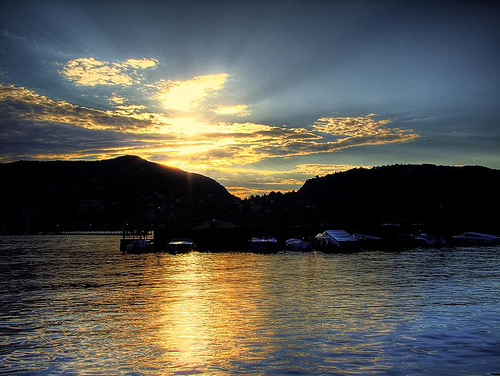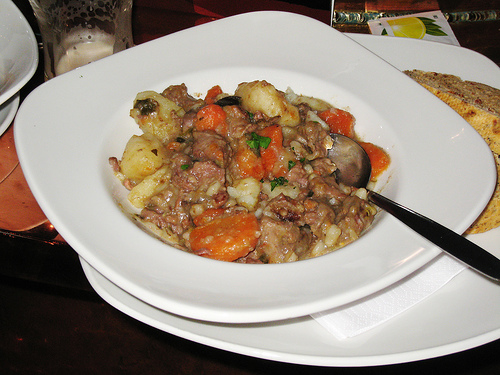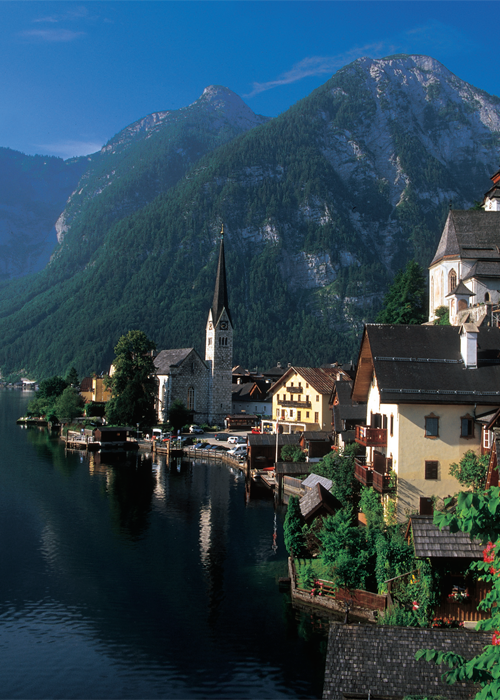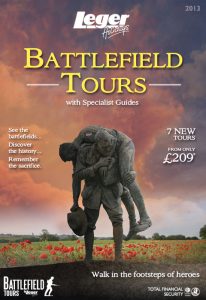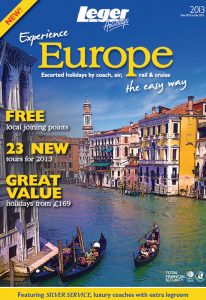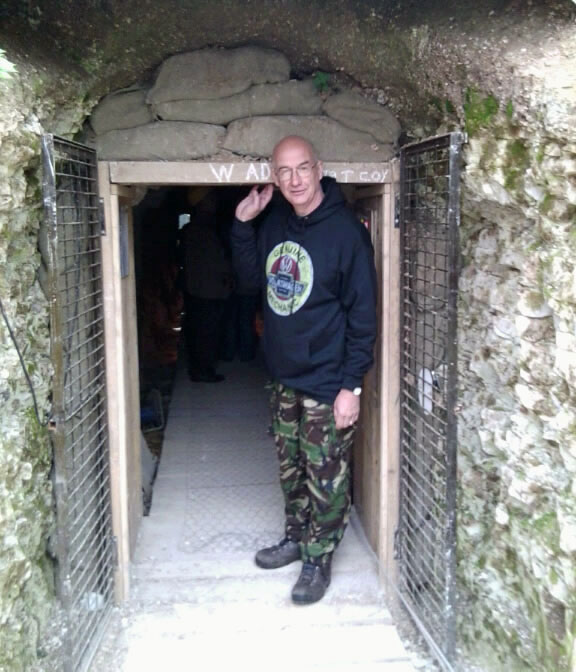Earlier this year we wrote about our favourite travel apps for the iPhone and now we thought it was time to do the same for Android devices.
From camera optimisation to travel organisers, these apps will ensure your holiday runs smoothly from start to finish.

1. Wikitude – Free
Without doubt Wikitude is the best augmented reality app available on Android devices.
If you’ve never used an augmented reality app before, the basic idea is that you can point your phone at something of interest and find out more about it. For instance, you could point your phone at a hotel and get TripAdvisor reviews, point it at local monument or place of interest and find out more about the area.
It’s a useful everyday app but really shines when you are in a foreign country!
2. Trip Journal – £2.99
Trip Journal is the perfect way to record where you’ve been and what you’ve seen. The app uses your GPS system to create a map recording where you’ve been, it allows you to store all your holiday pictures in a stylish album and lets you record your thoughts in a stylish journal.
Best of all, once you’ve created your journal you can share it on Facebook with all your friends.
3. Hipmunk – Free
Hipmunk is the ultimate travel companion. The app allows you to search and book hotels and flights whilst combining user reviews and price comparisons.
With Hipmunk you can also visualise where you will be staying using the built in maps functionality. You simply turn on heatmaps that show you the best areas to stay based on unique interests such as food, landmarks, nightlife and more.

4. Instagram – Free
Instagram is a real favourite at Leger Holidays. Not only does it make our rubbish snaps look professional, but the app makes it easy to share our adventures with friends and families.
All you have to do is take a quick picture and apply a filter to transform everyday moments into works of art you’ll want to share with everyone you know. It’s like having Photoshop in your pocket.
5. Currency Converter – Free
There’s nothing better than haggling with local market traders and coming back from your holiday with some absolute bargains. But when you don’t know the currency it can be difficult to know if you’re getting a good deal or not.
That’s where this handy map comes in. Currency Converter quickly and easily converts different currencies so you can see exactly how much you’re spending. It’s a bargain hunter’s best friend.
Do you have an Android phone? Have we missed any great apps? Let us know in the comments below.
Behind the Scenes at Leger Holidays
Our Product General Manager, Chris Plummer, oversees the planning and contracting of the Leger Holidays tour programme, along with the development of the product range and itineraries. Since graduating from Leeds Polytechnic in 1991 he’s worked in the travel industry and Chris has now been with Leger for five years.

As you’ve worked in the travel industry nearly 20 years you must have visited many places?
Yes, I’ve been lucky and seen most of Europe, in particular France, Italy, Austria and Ireland, plus America and Canada.
Are there any places that you’ve visited which really stand out for you?
I spent three months travelling America in 1996, which was a great experience, covering 38 states and a couple of brief visits into Mexico and Canada. So I’m particularly pleased that our America product, which was launched a few years ago, has been so well received by our customers.
I have also enjoyed visiting many of the great imperial cities of Eastern Europe, particularly Prague and Krakow.
Closer to home, the Italian lakes of Como, Maggiore and Garda take some beating. The scenery really is breathtaking; you just don’t tire of it.
And finally, Ireland is a country that holds a special charm – the people, the scenery, the seemingly laidback way of life, the Guinness – there is something we could all learn from the Irish.

Of the various cities you’ve been to where would you say is your favourite city?
Without doubt it has to be New York. There is no city like it in the world. The whole place just exudes a unique atmosphere and there is always something to do.
Vancouver in Canada is another great city.
In Europe, I would say Paris, which is a great place to walk around, be it the elegant boulevards, lined with shops, tranquil gardens and parks, or the winding streets around Montmartre.
Even though you are well travelled is there anywhere you haven’t been but would like to go, maybe if you won the lottery?
Winning the lottery would be great! One day I hope to visit Australia and New Zealand.
Where would you suggest if someone wanted to holiday in Europe and see some stunning scenery?
I’d give them the choice of three places – the North Italian Lakes, the Austrian Tyrol and the Norwegian Fjords. I simply couldn’t choose between them as they are all stunning places well worth a visit.
However, if it was fairytale snowy landscapes you were after, the Austrian Tyrol would be the place, as it is breathtaking at all times of year, but particularly in the winter.

Sometimes you need a holiday where sun and relaxation is top of the list. Where would you go?
Croatia is a great place and we used to go there a lot as a family when I was growing up. I’d love to go back sometime soon for some sun and relaxation. Further afield, I would say Mauritius as it is where I spent my honeymoon.
Where would you say is the best place to visit for history and heritage?
Definitely the classical Italian cities, such as Florence, Venice and Rome. Our Classical Italy and Jewels of Italy tours both encompass so much of what Italy has to offer. However, I would have to say Paris, the Palace of Versailles is amazing. The great
Italian cities have some great buildings too, such as the Colosseum in Rome and Doges’ Palace in Venice.
If a break away to do a spot of shopping was on the cards where would you suggest?
Really you’d be better asking my wife… although I did visit Cologne last year just before Christmas and the markets really got me in the festive mood….. although, I think the Glühwein helped!
I did manage to bring back some unusual Christmas presents and traditional treats for the family.
After the busy festive season it’s sometimes nice to have a spring break to look forward to. Where would you go?
I’d book a city break to somewhere like Paris, although I’m also a big fan of the Belgian cities of Bruges and Ghent.
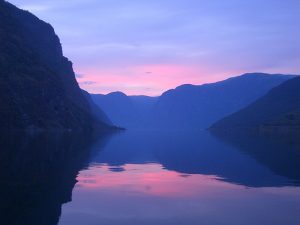
Where would you say is the best place to visit for amazing sights?
The fjords of Norway – charming cities like Bergen, breathtaking mountains and snow-capped peaks, deep blue fjords and lakes, glaciers and waterfalls – each corner brings something new.
When on holiday, many of us like to try the local food and drink available. I’m sure you have, so where would you recommend for delicious food and drink?
Italy, always Italy! There is so much choice when it comes to food. Also you’ll find the best wines in Italy, or so I am told by my former colleague Roland Clauw who has a few extra years experience on me!
A lot must go into planning a tour but what determines the itinerary?
A number of things – routing, hotels, convenient stops, drivers’ hours, excursions, costs, etc. We try to build things into an itinerary that are a little different from the norm. We like to see a tour as constantly evolving, through the input of coach crews and customers.
Itineraries and routings are looked at each year to see where improvements can be made.
How do you choose the hotels we use?
We have a number of criteria we work to. These include location, facilities, food, service, plus health and safety aspects. The trick is always to get the right balance and, of course, we want hotels which offer quality at a good price.
It is important to learn how the hotel works and to build up a professional relationship with the owner/general manager and key staff.
We regularly receive letters from our customers. Does customer feedback aid in the tour itinerary?
Yes, of course. All feedback is welcome, be it from staff, customers, drivers or whoever. Things can always be improved and the more input we receive the better.
And the final word goes to Chris…
When you talk to people outside of the industry they have this impression that it is the ideal job, as you get to see some great parts of the world, stay in excellent hotels and enjoy some fine food and wine along the way.
It really is a great job, which is why I’ve worked in travel for so many years, but those in the industry know there is a little more to it!
Images courtesy of flickr users Ben Fredericson, Selene Weijenberg and positivesustainability.
Destination Italy – A Country of Contrasts
Imagine being sat outside a restaurant along the shores of Lake Garda after a day filled with amazing scenery, fine buildings, works of art and lavish history with a delicious freshly baked pizza and a glass of fine wine, followed by one of many varieties of ice-cream and a first-rate Italian coffee. Heaven!
It’s easy to see why Italy appeals to so many travellers year after year. ‘La Bella Italia’ has it all! The serene elegance of Venice, Renaissance treasures of Florence, the ancient wonders of Rome, stunning scenery around Lake Garda, the romantic charm of Verona and the spectacular cliff-top panoramas of Capri. The chances are you’ll find much more than you ever dreamed of when you visit Italy.
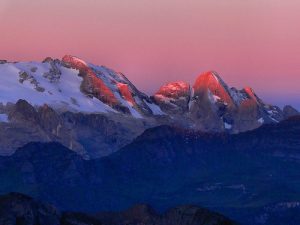
Best for Amazing Mountain Vistas
Picture the first rays of the morning, sun shining on the mountain tops and during the summer months forcing the wonderful alpine flowers into bloom on the surrounding pastures, or during winter reflecting off the crisp white snow.
The Italian Dolomites in the Sud Tirol are some of the most gorgeous mountain-scapes in Europe, dotted with pretty little villages and surrounded by lush green meadows.
From the tranquil Sud Tirol, the charming towns of Lake Garda with landmarks such as Riva’s Rocca Fortress and famous sights of Venice like St Mark’s Square and the Bridge of Sighs, are not too far away meaning true Italian culture and history can also be experienced.
Best for Superb Scenery and Sightseeing
The beautiful lakeside towns around Lake Garda have charmed visitors for centuries.
The southern lakeshore is low, rolling land. In contrast, the dramatic fjord-like northern end is surrounded by towering mountains and cliffs.
Most of the towns which nestle along the shore, such as Sirmione with its striking Scaliger Castle and Limone with its charming old fishermen’s houses and lemon groves, are popular as holiday resorts and have a very friendly and relaxed feel.
Wonderful sightseeing opportunities aren’t far away with the two largest cities in the Veneto area, Venice are Verona, just around the corner.

Best for Stunning Lakeside Views
Not far from the cosmopolitan city of Milan you’ll find stunning Lake Como, which has been a popular tourist resort since the days of the Roman Empire.
Visitors ever since have admired the clear blue waters, delightful lemon trees and olive groves and luxurious villas dotted in the wooded lakeside slopes above.
The best way to appreciate the beauty of the area is by taking to the water. You could visit two of the loveliest villas on the lake, Villa Carlotta and Villa del Balbianello.
Another stunning lakeside region is Lake Maggiore with its beautiful gardens growing rare and exotic plants. Once you spend time there you will soon become familiar with the name of the Borromeo family, who own the islands named after them.
Best for Excursion Variety
Visiting Italy really can mean mountains, lakes, city sights, shopping, history, architecture, relaxation and art all in one visit.
You can spend a day in each place and experience it all. Then maybe choose one of two of your favourite places and come back again next year.
Imagine two glorious weeks in a country of contrasts.
You could visit Lake Garda to experience the ambience and charm of this lovely area and finish the day off with a delicious ice-cream along the shoreline of Sirmione, then move on to Venice to see the maze of bridges, weaving canals and Renaissance architecture.
Next visit Rome, the ‘eternal city’ with its unique and colourful atmosphere built on its ancient Roman past with famous sights such as the Colosseum and Trevi Fountain.
Then have a more relaxing day in the popular resort of Sorrento on the Neapolitan Riviera with its many shops and fantastic views. You could see all of this and much more!
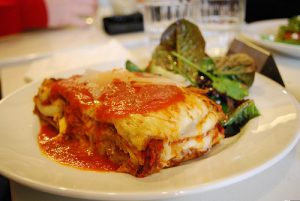
Italian Food… bellissimo!
The southern region of Italy is known for growing red, ripe, juicy tomatoes. Vegetables such as sweet peppers also grow with exuberance and are added to Italian dishes of the region.
Naples is king of pizza in Italy and claims to be the birthplace of one of the most popular Italian foods around the world.
Cheeses such as ricotta and mozzarella add richness. Northern Italian cuisine highlights dairy products with rich sauces made of butter, cream and eggs. Ingredients native to the area are used. Meat and seafood from the coast is also common.
You’ll find many pasta dishes to try in Italy. Common pasta sauces in Northern Italy include pesto and ragù alla bolognese, which usually adds meat to the sauce. In Central Italy there are simple sauces such as tomato, amatriciana and carbonara. Southern Italian sauces include spicy tomato, garlic and olive oil, with the pasta often paired with fresh vegetables or seafood. There are approximately 3,500 different types of pasta. Examples include spaghetti, macaroni, fusilli and lasagne.
Italian desserts range from sweet to slightly bitter and are always delicious. Many desserts are made from cookies and biscotti, which are flavoured with nuts, candied fruit and light glazes.
A custard dish from Siena is now very well known outside of Italy, tiramisu. The layered dessert includes biscuit fingers soaked in espresso, liqueur, eggs, cocoa, and mascarpone cheese.
No visit to Italy would be complete without trying the different varieties of ice-cream or ‘Gelato’. Traditional flavours include almond, chocolate, coffee, mint, pistachio, rum raisin, strawberry and vanilla. Ice cream took hold in Europe when Marco Polo brought the Chinese recipe to Venice in 1292. Now 54% of Italians eat ice cream at least once a week.
If you would like to escape to Italy with Leger Holidays then you can view our collection of Italian tours on our website now.
Images courtesy of flickr user Bill Stanley, digitalurbanlandscape and avlxyz.
A Great War Museum Right Next To Paris!
Built on the historic site of the first Battle of the Marne, the Musée de la Grande Guerre du Pays de Meaux, East of Paris, provides a fresh approach to the First World War, to discover its causes, its conduct and its consequences with regard to our world today.
An Incredible and Diverse Collection
Housing a collection unparalleled anywhere in Europe, the Musée de la Grande Guerre in Pays de Meaux offers a new vision of the First World War, through innovative scenography illustrating the great changes and upheavals in society that resulted from the conflict.
This collection is extraordinarily diverse, comprising almost 20,000 objects and 30,000 documents: armaments and artillery, items from everyday life on the front line or home front, heavy equipment, over 200 complete uniforms representing all the nations concerned as well as rich documentary and graphic arts collections.
The uniforms on display in the museum make up one of the largest collections in Europe devoted to the First World War.
Individual and larger weapons and pieces of artillery make up the second category of items in the collection.
Far from simply being an accumulation of items amassed over the course of the years, the collection gives a real understanding of world history and the stories of the people who suffered through this period.
Come to Meaux and Discover a Unique Great War Museum!
Leger Holidays are pleased to be able to offer our Battlefield customers the opportunity to visit this new and exciting exhibition. The museum is featured on Day 2 of our Miracle of the Marne and Battle of Verdun tour.
A Traditional Irish Stew Recipe with Guiness
With the nights drawing in and the weather getting colder by the day we thought it was the perfect time to share with you our recipe for Irish stew, it’s the perfect comfort food for a cold winters evening!
The recipe below takes around 2 hours to cook and should serve 4 hungry adults.
What you’ll need
600 grams of chuck beef stewing meat
6 cloves of pressed garlic
1.5 litres of rich beef stock
250ml of Guiness
250ml red wine
1.2kg potatoes
1 large onion, chopped
6 peeled and chopped carrots
1 tablespoon of dried thyme
Worcestershire sauce
Butter
Sugar
Olive oil
Salt & pepper
How to cook it
- To begin, heat some olive oil in a large, heavy stewing pot. Add some salt to your beef and fry the pieces until brown.
- Once your beef is nicely browned add in the garlic, beef stock, Guinness, red wine, tomato paste, sugar, thyme, Worcestershire sauce. Stir until the ingredients are mixed together, cover and allow to simmer on a medium heat for one hour.
- While the meet is cooking, add some butter to a frying pan and sauté the onion, potatoes and carrots until golden (around 20 minutes). Leave to one side until the meat has been cooking for an hour.
- Once the meat has been cooking for an hour, add the vegetables to your meat and simmer, uncovered, for around 45 minutes.
- Add some salt and pepper to taste and serve with a fresh crusty roll.
Make life a little easier
If you love this stew as much as we do you can make the stew in large batches and freeze it. It should keep for a few months in the freezer and is perfect for a quick, hearty meal after a long day at work.
Image courtesy of flickr user Charles Haynes.
Destination Austria – Discover an Alpine Gem
With its high mountain peaks and cobalt lakes, fascinating cities with palaces and parkland and distinctive delicious food, Austria has been a firm favourite with our customers for over 25 years.
Back in the 1980’s, Leger began operating holidays to Austria. Almost 30 years on, it continues to be one of our most popular holiday destinations.
Contrary to popular belief Austria is not all about mountains. While the Alps do cover three quarters of the country, dominating areas like Tyrol and Salzburg, the eastern provinces of Lower Austria, including Vienna, are more similar to the geography of the neighbouring Czech Republic and Hungary.
This diverse mix of landscapes is packed into a relatively small area and you’ll find everything glaciers, meadows and alpine valleys, to wooded foothills, gently rolling farmland, vineyards and river gorges.
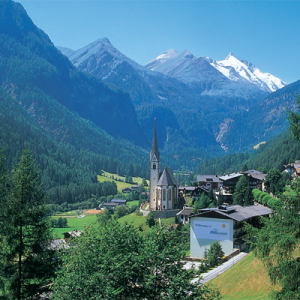
Best for awesome alpine scenery…
Some of Austria’s panoramic views are best seen by train. Imagine relaxing on an old steam locomotive and looking out onto breathtaking lakes and endless mountains.
The famous Ziller Valley Railway, in operation since 1902, runs from Fugen and takes you to Mayrhofen, situated near the Hintertux glacier, which, at 3250m above sea level, is above the snowline.
There’s also the nostalgic Gisela train, which transports you back to the romance of the good old days. Along the journey the train travels through the valleys of the Kitzbühel Alps, passing alpine villages and little towns dating back to the Middle Ages.
If this sounds good, you could try our Little Trains of Austria tour, which also visits Capital of the Tyrol’ Innsbruck; Lake Achensee, the largest lake in the Austrian Tyrol; and St. Wolfgang, home of the cog railway.
Best for ‘Sound of Music’ highlights…
In 1965 Salzburg was the setting for a film which would become world famous – ‘The Sound of Music’.
There are some fantastic sights to see in the city including the Mirabell Gardens, where, in the film, Maria and the children were seen dancing around the statue of Pegasus, the winged horse, and throughout the gardens singing ‘Do-Re-Mi’. Also, Mondsee Cathedral, where the wedding between Maria and Baron Von Trapp was filmed.
Salzburg is also the birthplace of Wolfgang Amadeus Mozart, and you can visit the fascinating museum, housed in the Mozart family home, where Mozart composed much of his early work.
You could experience the ‘Sound of Music‘ for yourself on our tour which also visits Alpbach, voted ‘Austria’s most beautiful village’, Krimml Falls, which gives views considered to be unsurpassed throughout Europe, and Swarovski Crystal World, where you can treat yourself to a holiday memento.
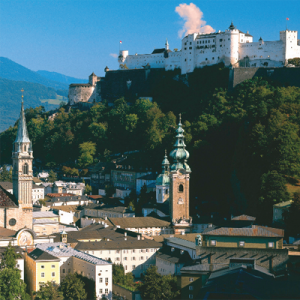
Best for city sightseeing…
The city of Innsbruck is awash with architectural gems including superb examples of Gothic, Baroque and Renaissance architecture, Imperial residences and museums.
The Imperial Palace is in the Baroque style and has four wings and a splendid two-story Riesensaal (Giant’s Hall), painted in white and gold.
However, Innsbruck’s most popular attraction is the Golden Roof, which is a three-story balcony on the central plaza at the heart of the Old Town. It was constructed for Emperor Maximilian I to serve as a royal box where he could sit in luxury and enjoy tournaments in the square below.
One of the most beautiful cities in Austria is Salzburg, with its towering spires, green hills and romantic gardens. Salzburg means ‘salt castle’, referring to its massive fortress and the white gold from the mountains in the south. The city’s magnificent baroque town centre is rated as a UNESCO World Cultural Heritage site and can easily be explored by strolling along the winding alleyways and through the charming squares.
You could join us on our Spectacular Austria all inclusive tour, where you’d also go to picturesque Zell-am-See, the ski resort town of Kitzbuhel and beautiful Achensee and the Ziller Valley.
Best for spectacular snowy scenes…
It’s not often we see clean crisp white snow here in the U.K. but if you take a relaxing break to Austria, it’s highly unlikely you’ll be disappointed. A blanket of snow transforms the lush, green landscape to the perfect winter wonderland, so taking your camera is a must!
Get your scarf and gloves on and take a stroll along Lake Zell in Zell-am-See. This is one of the most beautiful scenic regions of Austria, with the village on the shore, backed by the 6500ft Schmittenhohe Mountain. The centre of the town is pedestrianised with delightful flower-decked street cafés and shops to browse in, plus many good restaurants.
Then there’s Kitzbühel, a ski resort in the heart of the Alps. Explore the walled Old Town or take a horse and carriage ride through the snow, Then stop in a café for a lovely warm drink.
Try our Austrian Winter Wonderland tour where you’ll also get to ride on the over a century old Ziller Valley Railway and visit enchanting Salzburg.
The Three Best Cities to Visit in Denmark
Denmark is the southern most Scandinavian country and consists of the Jutland Peninsula and over 400 islands, some of which are linked to the mainland by bridge. The country is relatively flat and everywhere you go you will see windmills and traditional thatched cottages. Denmark is a relaxed country, and despite its small size, has a great deal of history. Below we look at the countries three best cities to visit on a trip to Denmark.
Copenhagen

A thousand years of living history awaits you in the wonderful Danish capital. There are pretty medieval cobbled streets, 17th century canals, stunning modernist architecture, and the city is home to Hans Christian Anderson’s fairytale ‘Little Mermaid’. A bronze statue of the mermaid is perched on a rock overlooking the port and attracts more than a million visitors each year. Copenhagen never stands still, yet always has plenty of time to appreciate its remarkable past.
Helsingor
This picturesque harbour town is known internationally as the setting of William Shakespeare’s ‘Hamlet’, in which it was spelt Elsinore. The area in and around Helsingor has been called ‘The North’s Riviera’ since the beginning of the last century and toasts beautiful sandy beaches. The Palace Gardens are popular and cover approximately 120 hectares and are some of the largest and best preserved in Denmark. Kronborg Castle, built in the Dutch Renaissance style, is worth a visit and an ariel view shows the defenses form the shape of a crown.
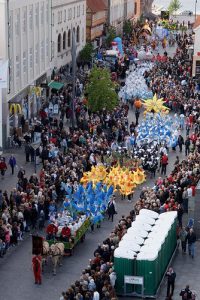
Aalborg
Situated in the north of Denmark, Aalborg is the third largest city in the country in terms of population. Despite its size, Aalborg isn’t that well known to tourists and so it keeps hold of much of its traditional charm. Filled with cobbled streets, traditional homes and quaint shops the city offers a relaxing atmosphere for tourists. However, if you visit the city during the famous Aalborg carnival it will definitely be a little livelier! The carnival is usually held on the last weekend of May and features thousands of people all dressed up in fancy outfits, lots of music and dancing and a grand firework display.
If you are considering a holiday in Denmark or any part of Scandinavia this year then why not check out our full selection of Scandinavian tours on our website.
Images courtesy of flickr users Christoffer Mørch and Kevin Burkett
Secret Underground War Site Revealed!
The village of La Boisselle sits on the front lines that ran across the Picardy countryside prior to the 1916 Battle of the Somme. When the British took over the sector from the French in the summer of 1915 the ground had already been heavily fought over.
By July 1916 the ruined village was fortified and in German hands, enclosed by a maze of trenches and divided from the British lines by a belt of mine craters, evidence of a separate war that took place below the ground.

Today, there are still visible reminders of the fighting.
Many Leger travellers will have visited the huge Lochnagar Crater, a few hundred metres south of the village, the result of 60,000 lbs of explosive blown at 07:28 hrs on the morning of 1 July 1916. The sharper eyed amongst you will have spotted the chalky outlines of the former trenches snaking their way across the now peaceful fields.
As your coach made its way towards the crater, many will have had their attention drawn to an area of rough ground on the southeastern edge of La Boisselle. This 2- hectare piece of privately owned land is known as the Glory Hole. Still scarred by mine craters, it is now the subject of a long term, in-depth archaeological, historical, technological and genealogical study by the La Boisselle Study Group.
As a result of a personal plea for help by the French landowners, historian Peter Barton brought together an international group of specialists to form the La Boisselle Study Group.
I became one of the founder members, and in 2011 between Leger battlefield tours, I worked with the landowners and project members clearing many years of tree and vegetation growth.
The Group has its own team of dedicated archaeologists led by Anthony Byledbal of the University of Artois.
The ground clearance exposed more mine craters, shell holes and vestiges of trenches. Stormy weather had also caused a small collapse on the land which revealed a tunnel (X incline) leading to a chamber off which a further incline (W Adit) led up towards the surface.
In the chamber was a 50-foot deep shaft, that connects the 30-foot level with the main fighting tunnels at a depth of 80 feet. The entire Glory Hole sector has an estimated 5 miles of tunnels beneath it.
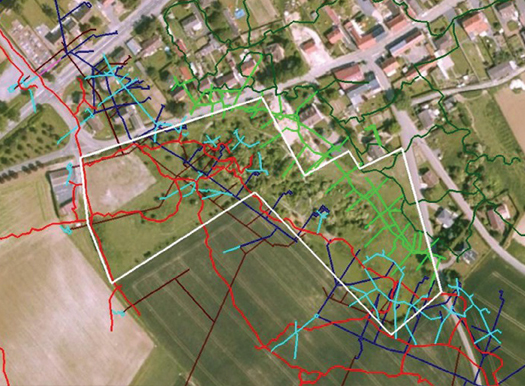
The allied tunnels descend to 100 feet and consist of three main levels. Facing them was a slightly deeper German system, together they formed a secret underground battlefield in which men fought until the beginning of the Battle of the Somme in 1916.
Archival and genealogical research in the UK and France has shown that there are still at least 38 French and British soldiers buried in the deep tunnels, victims of the underground war.
Research continues in Munich and Stuttgart to reveal the German side of the story and will lead to the identification and location of missing German miners. These men were lost beyond recovery, entombed in the galleries by underground explosions. It is a purpose of the project to ensure that they remain undisturbed in perpetuity and that their resting places are permanently marked on the surface above.
With a contract and archaeological permission in place, and with continuing archival research in the UK and Germany, October 2011 saw the first week of excavations at the site.
The team focused on the entrance to X incline, a small section of Quémart Trench, and locating the head of W Adit. It was a week that eventually saw the head of W Adit open for the first time in over 90 years.
The entrance and tunnel was made safe, the site interpreted and signed, and an Open Day held for the local people. Many hundreds visited the site, astonished to see what lies beneath their feet.
With the support of the landowners, from the very outset of the project the LBSG has had public access at the core of its philosophy. If we are working, the site is always open. The project’s profile is therefore already of the highest order, and our work continues to draw intense media interest. You may have seen coverage on BBC News and in newspapers and magazines.
In addition Peter Barton was historical consultant for the recent BBC adaptation of Birdsong, and the LBSG hosted a visit to the Glory Hole and tunnels by actors Eddie Redmayne and Joseph Mawle to experience a special understanding of the roles they were to play.
Further engineering and archaeological work has concentrated on clearing W Adit and exposing the original floor of the incline which has revealed the original tramway running from surface to shaft.
Work continues, and Peter Barton and Mike Fox have been commissioned by the BBC to produce a documentary on the underground war, utilising the site at La Boisselle.
In order to launch the project in time for the 2014 commemorative period, the LBSG have so far funded the project from their own pockets and through donations by friends and individuals.
This can no longer continue, and a dedicated fundraising campaign is now underway with many large companies, including Leger Holidays, coming on board as sponsors. The money raised will allow us to continue the archaeology and exploration, and eventually achieve the key long-term aim of preserving the site in perpetuity and erecting memorials commemorating the many men still buried beneath.
Leger Holidays rose to the challenge and kindly agreed to sponsor the project. In return we are putting together a specialist tour on the history of the underground war in the Ypres Salient and Somme to run in October 2013.
The Somme day will include a special visit to the Glory Hole and offer a chance for all on board to visit the ongoing archaeological work. The La Boisselle Study Group will be present on site to guide people both on the surface and underground, and to answer questions regarding the project and the underground war.
An exhibition of maps, tunnel plans, photographs and artefacts recovered so far will also form part of this special visit designed exclusively for Leger travellers.
Given the tremendous international interest that the centenary of the Great War is already generating in the media, and the unique nature of the project, the Glory Hole will form one of the prime focal points for education, commemoration and memorialisation throughout the 2014 – 2019 period. The British tunnelling campaign remained an official secret until 1962 and second to the espionage war remained the most secret type of warfare employed against the enemy.
Join us on this special tour to explore and learn about this secret troglodyte war.
Leger's new brochures are out now!
Leger Holidays’ brand new 2013 brochures are out now and are filled with early booking savings of up to £100 and tours from just £109.
You can view our new brochures online now by clicking on the relevant image below.
Alternatively, you can visit our website and ask for a copy to be delivered to your door free of charge!
The Underground War by Rod Ingram
Earlier this year Rod Ingram joined Leger Holidays on our tour – The Underground War – Tunnellers on the Western Front. This exclusive tour explores the ‘lost labyrinth’ of tunnels that played a huge role during the Battle of the Somme.
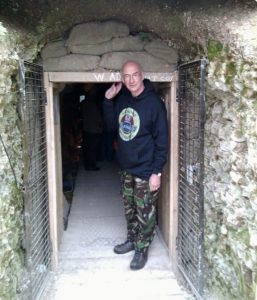
Below, Rod shares with us his experiences whilst on this tour…
‘Having followed the work of the La Boisselle Project online for some months now, and experienced eight very interesting and enjoyable WW1 tours with Leger previously, when I saw that Leger was advertising The Underground War: Tunnellers on the Western Front tour I jumped at the opportunity to visit the site and see the tunnels first-hand.
And what a wonderful experience the tour turned out to be!
After the usual trouble-free interchange, we crossed to France and arrived at our hotel in Mouscron where we were greeted by our tour guide Iain McHenry (I was delighted to see Iain as he is a veritable walking encyclopaedia on the First World War). The hotel was an excellent choice; the rooms were very pleasant, the staff were friendly and it was quiet in the evenings even thought it was situated right next to the town square.
After a restful evening and a hearty breakfast we began the first day with a tour of the Salient. Our first port-of-call was Hill 60, a location that I had visited only three weeks earlier on the VCs of the First World War tour, but Iain, our guide, brought a fresh perspective to the location and really brought it to life.
Our journey continued to Zonnebeke to see the Passchendaele Museum and Dugout Experience which I found extremely interesting and – despite my many trips to the Salient – I had never been to this location before. Lunch was taken at Hooge where we were treated to an impromptu performance from a visiting pipe and drum band. The sound of the haunting pipes floating across the battlefields was a very poignant moment and it is a memory that will remain with me for a very long time indeed.
The afternoon was spent on the Messines Ridge (the scene of the ‘big bang’) and for the remainder of the day we criss-crossed the Salient to visit the memorials and graves of the many Tunnellers that had lost their lives there. We ended the day with the Last Post service in Ypres during which two bands (who were coincidentally in town for the Ypres Tattoo on the following day) marched through the town centre to the Menin Gate and played at the service. Even the tour guide commented that it was an exceptionally moving service.
Day three saw us travelling to the Somme to visit the La Boisselle Project. We were greeted at the site by Peter Barton (yes, he does wear that hat all the time!) and his delightful team who gave us an extremely interesting tour of the site and took us in small groups down into the tunnels.

It was marvellous to see first-hand the artefacts that were being discovered and the excellent work that is being done there. After a lunch kindly organised by our tour guide at the Old Blighty Tearoom, we set out across the Somme battlefields to the Lochnagar Crater – a site that is always inspiring each time I visit it – then on to Beaumont-Hamel to see the Hawthorn Crater.
On our travels we visited the scene of the Livens Flame Projector which was graphically described by our tour guide who had worked on the project to recover one of the projectors. The day concluded at Thiepval which brought to a close two very long, but very jam-packed, enjoyable and interesting days.
All-in-all The Underground War tour was an exceptional experience and I have returned home with a wonderful set of photographs from the battlefields and an equally wonderful set of memories that will remain with me forever. I would like to thank everyone at Leger (especially Iain) who made the tour such a fascinating, informative – and at times, extremely moving – experience…and now to start planning next year’s tour!’
If you would like to explore the tunnels with Leger Holidays in 2013 you can book online now, and if you use the code “EBM13” and book before the 30th of November 2012 you can save £20pp!


